![]()
![]()
![]()
Use LEFT and RIGHT arrow keys to navigate between flashcards;
Use UP and DOWN arrow keys to flip the card;
H to show hint;
A reads text to speech;
34 Cards in this Set
- Front
- Back
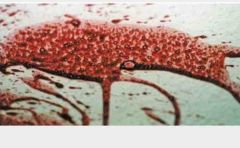
Front (Term) |
Expirated Spatter |
|
|
General Features of Bloodstains |
Direction from which blood originated. Angle at which a blood droplet struck a surface Location or position of a victim at the time a bloody wound was inflicted Movement of a bleeding individual Minimum number of blows to a victim Approximate location of individual delivering blows. |
|
|
Hard Surface |
Cause less spatter. When a drop falls straight down it is cylindrical. |
|
|
Porous Surface |
Tail when dropped straight down. Pools get absorbed easily and are not accurate. |
|
|
Satellite Spatter |
Small drops of blood that are distributed around the perimeter of a drop and were produced as a result of the blood impacting the target surface. |
|
|
90 degree drops |
Circular. As the angle deviates, it becomes more elongated |
|
|
Angle of impact equation |
Sin(Theta)=Width/Length |
|
|
Impact Spatter |
Bloodstain pattern produced when an object makes forceful contact with a source of blood projecting drops of blood outward from the source. |
|
|
Forward Spatter |
Blood that travels away from the source in the same direction as the force that caused the spatter |
|
|
Back Spatter |
Blood directed back toward the source of the force that caused the spatter |
|
|
Low Velocity Spatter |
Travels at 5 feet per second. Drops are greater than 3 mm in diameter |
|
|
Medium Velocity Spatter |
5-25 feet per second. Drops have a diameter of 1-3 mm. |
|
|
High velocity spatter |
100 feet per second or faster. Drops that are less than 1 mm in diameter. Many of these fall to the ground |
|
|
Area of Convergence |
Point from which the drops originated. 2-D |
|
|
Area of Origin |
Location from which the blood projected in 3-D space. |
|
|
Gunshot Spatter |
Characterized by back and forward spatter. Presence of back spatter is dependent on distance between the victim and the firearm. Medium and large drops may be present. Back spatter may also strike the gunman and enter the gun muzzle |
|
|
Cast-off Spatter |
Arched pattern that is created when blood is flung from a blood bearing object in motion onto a surface. Width of stain is caused by the object/weapon. Shows minimum number of blows. |
|
|
Arterial Spray |
When a victim suffers an injury to a main artery or heart. Heart pumping causes blood to spurt. Brighter in color because the blood is oxygenated. |
|
|
Void Patterns |
Created when an object blocks the deposition of blood onto a surface. |
|
|
Contact/Transfer |
A surface that carries wet blood comes into contact with a second surface. |
|
|
Flow |
Blood flowing due to the pull of gravity. May show movements of objects or bodies. |
|
|
Pools |
When blood collects in a level, undisturbed place. |
|
|
Skeletonization |
Occurs within 50 seconds of deposition of blood. Edges of the stain dry. |
|
|
Drip Trail Patterns |
A series of drops that is separate from other patterns. Formed by blood dripping off an object or injury. |
|
|
Expirated Blood Pattern |
Blood that is expelled by the nose or mouth. Has air bubbles and lighter in color because it is diluted by saliva |
|
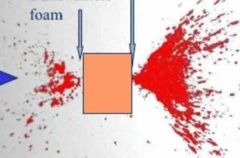
|
Forward and backward spatter |
|

|
Gunshot spatter |
|
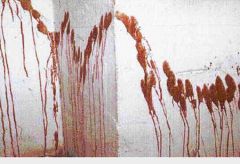
Front (Term) |
Arterial Spray |
|
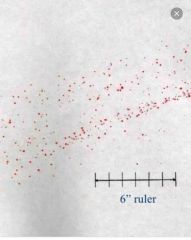
|
Cast-off Spatter |
|
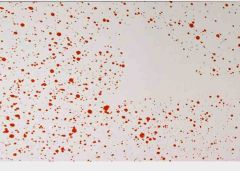
|
Void pattern |
|
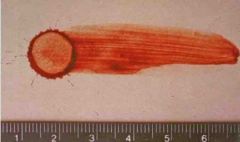
|
Skeletonization |
|
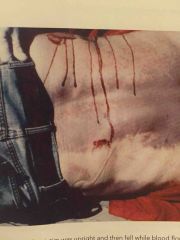
Front (Term) |
Flow |
|
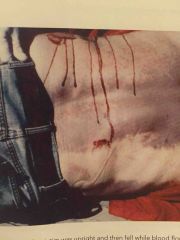
Front (Term) |
Flow |
|

Front (Term) |
Transfer |

